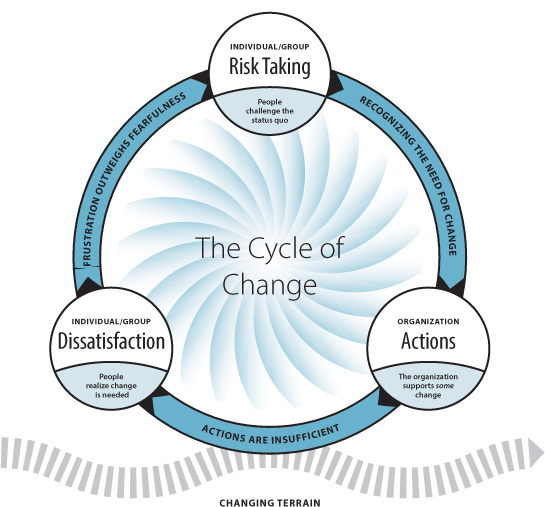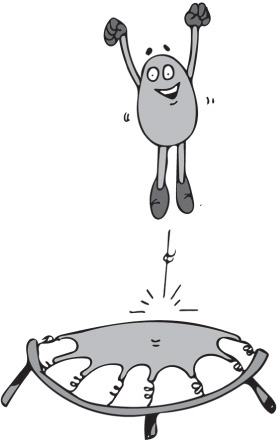On Your Own
In a Level One organization, there is no awareness of the importance of safe interactions in the workplace. There is no understanding that the quality of people’s interactions with one another might affect the quality of their work experience or their effort, output, and ability to collaborate with one another.

At Level One, there is no focus on interaction safety. People are expected to fend for themselves.
In other words, you’re on your own.
Let’s explore how people interact at Level One.
Compare what happens here with what happens in your workplace. If these things seem normal to you, it is likely that you work in a Level One workplace.
In a Level One workplace, people compete to show their merit and worth. Until they pay their dues and establish themselves in the organizational pecking order, they must constantly prove themselves. New ideas and new people are scrutinized with suspicion.
New people are often ignored, hazed, harassed, or bullied. “Incidents” are ignored, explained away as misunderstandings, or blamed on the newcomer who “hasn’t learned the ropes.”

At Level One, you keep your head down and learn your place.
People judge one another constantly. Some people put down other people’s ideas so they can advance their own. Many others keep their ideas to themselves to avoid criticism. Conversations include sarcasm, put-downs, criticism, mean jokes, and subtle and not-so-subtle digs.
You are expected to give as good as you get. If you can’t, you learn to shut up, keep your head down, and stay out of the way.
If you make a mistake or even a minor slipup, you are judged and not given the benefit of the doubt. You might be dressed down publicly in meetings or email chains.
If you get labeled, the label is likely to stick for a long, long time because people have long memories. Many find it’s easier to just keep their ideas to themselves to avoid criticism.
People who complain about the environment are identified as “whiners.” Whiners are easy targets for increased bullying. They either learn to keep their problems to themselves or leave.

People walk on eggshells.
It’s safer to be small and not stick out.
Safety beyond the physical, life-threatening sense is ignored at all levels: individual, group, and organizational. When the organization signals that raising issues about problems with products or processes—the actual work being done—isn’t okay, people quickly realize that voicing their own feelings regarding interaction safety is dangerous.

We know better than to be the bearers of bad news because they shoot the messengers.
Speaking up about interaction safety issues regarding team members and managers is taboo. Raising organizational problems of any kind happens mostly in exit interviews . . . or is likely to lead to one.
There is no awareness of the barriers people face that prevent them from expressing their ideas or doing their best work. It is simply not in the organization’s Way of Life.
Leaders see and describe any discussion of interaction safety as “soft stuff” and see it as a waste of time. There is a belief that people should just get on with the work at hand.
Harry is fed up. He’s decided it’s time to talk to his manager. He has come to expect sarcastic remarks in meetings, but after years of putting up with it, he finds his confidence eroding. It isn’t spoken about much, but he can tell that more and more of his colleagues feel the same way. The last time one of Harry’s colleagues spoke up, he got slammed for it. The same has repeatedly happened to others.
Harry has decided he can no longer tolerate this. He knows he has some great ideas to share, but the effort it takes to get a new idea discussed and the reaction he receives are sapping his energy. He feels many of the meetings he participates in are a waste of time. People are not sharing their thoughts because it is just not safe enough. Generally, people only discuss real issues in the “meeting before the meeting” (or after)—not with managers or others they don’t know well, but privately with team members they can trust.
Harry decides to raise his concerns with his manager, with whom he has a good relationship. When he does, his manager responds with appreciation that Harry has shared his concerns, but then he adds, “C’mon Harry, you know how it is around here. Don’t take it personally. That’s just the way it is.”
Harry realizes what his manager has said is true. He decides he is just going to do his job and keep his head down . . . just like the rest of his colleagues.
![]() People are afraid to speak up.
People are afraid to speak up.
![]() When it comes to interacting with leaders, people only speak when spoken to.
When it comes to interacting with leaders, people only speak when spoken to.
![]() Minefields are everywhere, so you tread carefully.
Minefields are everywhere, so you tread carefully.
![]() If you make a mistake, it is remembered and could be career limiting, even if it is small.
If you make a mistake, it is remembered and could be career limiting, even if it is small.
![]() People have to look out for themselves.
People have to look out for themselves.
![]() New people must be quiet and wait their turn.
New people must be quiet and wait their turn.
![]() When good performers leave, the organization says negative things about them to justify their leaving.
When good performers leave, the organization says negative things about them to justify their leaving.
![]() There are lots of unwritten rules. If you haven’t been around long enough to know them, it is safest to keep your mouth shut.
There are lots of unwritten rules. If you haven’t been around long enough to know them, it is safest to keep your mouth shut.
![]() Leaders are not comfortable with people pushing back or bringing their own thinking to the table.
Leaders are not comfortable with people pushing back or bringing their own thinking to the table.
![]() Jokes, ridicule, and even hazing are common.
Jokes, ridicule, and even hazing are common.
![]() People don’t give each other the benefit of the doubt—you have to prove yourself continually.
People don’t give each other the benefit of the doubt—you have to prove yourself continually.
![]() If you complain about someone being disrespectful, you are coached to tough it out and ignore statements that might be demeaning.
If you complain about someone being disrespectful, you are coached to tough it out and ignore statements that might be demeaning.
![]() If a particular leader seems to punish, bully, or judge team members, people will say, “That’s just the way she/he is,” or position it as a virtue. The leader is “demanding” or “has high standards.” They might suggest you transfer out of that leader’s area as others have done.
If a particular leader seems to punish, bully, or judge team members, people will say, “That’s just the way she/he is,” or position it as a virtue. The leader is “demanding” or “has high standards.” They might suggest you transfer out of that leader’s area as others have done.
![]() In meetings, people commonly punch holes in each other’s ideas.
In meetings, people commonly punch holes in each other’s ideas.
![]() Even when people agree, the agreement starts with, “Yes, but...”
Even when people agree, the agreement starts with, “Yes, but...”
![]() People are rewarded more for criticism than for critical thinking.
People are rewarded more for criticism than for critical thinking.
![]() People compete to demonstrate that they are the smartest in the room.
People compete to demonstrate that they are the smartest in the room.
![]() People walk on eggshells. They worry that any mistake they make will be long remembered.
People walk on eggshells. They worry that any mistake they make will be long remembered.
![]() People who report incidents are as likely to be blamed for them as the parties they lodge complaints against. All parties involved may be warned about the consequences if the behavior happens again.
People who report incidents are as likely to be blamed for them as the parties they lodge complaints against. All parties involved may be warned about the consequences if the behavior happens again.


In a Level One organization, new ideas and new people are not often welcomed...
. . . as Pat, a new hire, is learning.
A new hire, Pat, is a highly prized recruit. The company’s hiring staff spent months searching for, recruiting, vetting, and finally hiring Pat. They believe she will bring fresh perspectives and expertise the company sorely needs. The company hopes, based on her track record and their interactions with her, that Pat can make an immediate impact in their sales and customer satisfaction.
In her first weeks on the job, Pat feels her new colleagues are being polite but cautious. She can tell they are keeping her at arm’s length. When she makes a suggestion, her colleagues point out all sorts of flaws in it. They make comments like, “You don’t understand the situation here yet,” and, “We tried something like that before and it didn’t work,” and, “That’s not the way we do things around here.”
Some of her more sympathetic teammates take her aside and coach her to slow down, relax, and “learn how we do things here.”
Pat had been warned that joining the organization could be tough, and she came into the job with her eyes open, excited about this new opportunity, and certain she was strong enough to handle it. She had been in other organizations that were “sink or swim” but was always successful in those environments.
Although Pat was expecting some of this, she is finding herself exhausted each day when she leaves work. Before long, she stops bringing in her new ideas. After six months at the company, Pat is thinking it might be time to update her resume once again. She thinks that if she left, no one would really care.
How We Interact in Meetings: Level One
“Normal” behaviors, interactions, and responses
Written rules and road signs |
There are no statements about the importance of interaction safety. |
When someone is talking |
Keep your head down. |
Interactions with the meeting leader |
It is the leader’s meeting. |
Interactions with other team members |
Only interact with other team members when absolutely necessary. |
When someone challenges an idea |
Go on the attack or avoid interaction. |
Outcome of interactions |
Interactions are passive-aggressive. Time and energy are wasted. There is no trust, inclusion, or collaboration. |

Leaders in Level One organizations are often thought of as “bosses.”
Mary, a senior vice president, is Tony’s boss.
Mary’s team is working on a critical project. The team has been making good progress, but today Tony sent Mary and the other team members an email about a major problem that will delay the project by at least three weeks.
Mary is furious. She fires off an email to Tony—copying the rest of the team—telling him this is unacceptable. Her email starts off, “How could someone with your knowledge let this happen?” The rest of her reply expresses her opinion of Tony’s ineptitude in not foreseeing the problem. After sending the email, Mary feels better for having made her point. She is sure it will keep Tony and the team on their toes.
Tony and the team members have become numb to such outbursts from Mary. This latest outburst reminds them of why they spend so much time working around Mary and hiding problems from her whenever possible.

People who don’t fit the organization’s traditional profile are few and far between.
Akasha often hears she is “different” from how others expected her to be.
Akasha realizes that hardly anyone in the company is treated with respect. At first, she felt she was being treated more harshly because she was one of the few women of color. Now, she sees that many, if not most, people in the company are treated disrespectfully. This realization was somehow almost comforting.
She is aware of the fine line she must walk to be successful. In a recent meeting, Pablo, a facilitator, was called Pancho, which she knew was intended as a derogatory remark. Akasha often hears people in meetings telling jokes about others not in the room. Sometimes she hears colleagues using offensive terms to refer to others. She doesn’t join in, but she feels as if she is colluding by staying silent and watching other people in the room laugh.
She recently heard that a senior leader made a homo-phobic remark at an offsite meeting, and another leader, in front of others, “jokingly” threatened to hit a team member with a bat... and neither leader’s behavior was addressed or even criticized.
Akasha has been told she has a bright future with the company. She works hard to demonstrate her competence every day in order to fit in and make others feel comfortable around her. Yet there are many moments when she feels alone, with few people to talk to about how her differences and experiences affect her daily life in the organization. She is noticing that not only is she withdrawing personally but she is also more hesitant to voice her ideas.

Moving to the Next Level

Roots of Dissatisfaction
Here are some of the signs of dissatisfaction at Level One.
![]() There is fear of retribution for challenging the status quo.
There is fear of retribution for challenging the status quo.
![]() A high value is placed on conformity and loyalty to current cultural norms.
A high value is placed on conformity and loyalty to current cultural norms.
![]() There is an assumption that leaders know best.
There is an assumption that leaders know best.
![]() An “us versus them” mind-set is prevalent.
An “us versus them” mind-set is prevalent.
![]() Any difference is seen as a threat.
Any difference is seen as a threat.
![]() People are punished—put down verbally, sidelined for development opportunities, labeled as troublemakers—if they step outside the current norms. They must fit in.
People are punished—put down verbally, sidelined for development opportunities, labeled as troublemakers—if they step outside the current norms. They must fit in.
![]() People feel judged.
People feel judged.
![]() People who raise a problem get labeled as the problem.
People who raise a problem get labeled as the problem.
![]() In meetings, people have to remain silent and watch as their colleagues are made small or outright attacked.
In meetings, people have to remain silent and watch as their colleagues are made small or outright attacked.

So, what can you do to move to Level Two?
Individual Actions: Taking Risks
![]() Be willing to let at least one other person know that you are feeling bullied or diminished.
Be willing to let at least one other person know that you are feeling bullied or diminished.
![]() Engage team members and others you trust about how to create safer interactions.
Engage team members and others you trust about how to create safer interactions.
![]() End the collusion of silence: Don’t laugh at jokes that put others down. Support others when they are not being treated with respect and are made small (for example, through sarcasm or bullying behavior), even if that support has to be given privately.
End the collusion of silence: Don’t laugh at jokes that put others down. Support others when they are not being treated with respect and are made small (for example, through sarcasm or bullying behavior), even if that support has to be given privately.
![]() Identify and share what you need to feel safe (for example, letting people know how they can support you or asking someone to have your back when you are not present).
Identify and share what you need to feel safe (for example, letting people know how they can support you or asking someone to have your back when you are not present).
![]() When an email chain includes name-calling, don’t engage. If you are directly involved, pick up the phone and talk to the individual.
When an email chain includes name-calling, don’t engage. If you are directly involved, pick up the phone and talk to the individual.

Leaders:
Here are some things you can do to make interactions safer for your team members.
Leader and Organization Actions
![]() Stop accepting an unsafe environment as “normal” or just the way things are.
Stop accepting an unsafe environment as “normal” or just the way things are.
![]() Let team members know you will not accept sarcasm, put-downs, or judging behavior within your team.
Let team members know you will not accept sarcasm, put-downs, or judging behavior within your team.
![]() Identify and eliminate your behaviors that may be experienced by others as put-downs.
Identify and eliminate your behaviors that may be experienced by others as put-downs.
![]() Establish organizational anti-harassment policies.
Establish organizational anti-harassment policies.
![]() Provide protection for whistle-blowers.
Provide protection for whistle-blowers.
![]() Track incidents and complaints.
Track incidents and complaints.

On to Level Two




